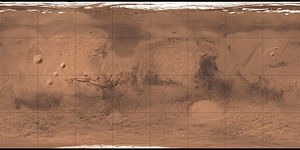Vastitas Borealis
| Plane on mars | ||
|---|---|---|
| Hadriacus Mons / Hadriaca Patera | ||

|
||
| Vastitas Borealis is the large plain at the top of the topographic map image. | ||
|
|
||
| position | 88 ° N , 33 ° E | |
| expansion | 2000 km | |
Vastitas Borealis (vastitas, Latin , desert , used in the IAU Mars nomenclature for large plain ; borealis, Latin, north ) is the largest flat plain on the planet Mars . It is located in the northern latitudes of the planet and surrounds the northern polar region, called the Planum Boreum . Vastitas Borealis is often referred to simply as the northern plain of Mars or the Borealis Basin. The plain is about 4–5 km below the average radius of the planet.
In 2005, the Mars Express Mars probe of the European Space Agency photographed a considerable amount of water ice in a crater in the region. The environmental conditions in the region enable water ice to remain stable there. It was discovered when overlying carbon dioxide ice evaporated during the Martian summer.
In August 2007, NASA launched the Mars probe Phoenix , which landed in the Vastitas Borealis on May 25, 2008, that is, during early summer in the northern hemisphere of Mars. It was a stationary probe that u. a. Took soil samples. Among other things, various minerals, but also perchlorates were found. Phoenix was sending scientific data through November 2, 2008. Further attempts to contact us in 2010 were unsuccessful. One picture showed signs of severe damage from icing.
description

The northern part of Vastitas Borealis is covered by large and small dune fields . The largest dune field on Mars, Olympia Undae ( 81 ° 10 ′ N , 178 ° 29 ′ E ), is over 1500 km long. Deposits of gypsum were discovered here. It could have been caused by a runoff of meltwater from the Chasma Boreale trench to the north.
Moraines (deposits that are moved or piled up by glaciers as they move) ( 74 ° 40 ′ N , 95 ° 16 ′ E ), possibly formed by carbon dioxide glaciers , could also be observed .
Web links
- Martel, LMV (July, 2003) Ancient Floodwaters and Seas on Mars. Planetary Science Research Discoveries . http://www.psrd.hawaii.edu/July03/MartianSea.html
- DLR: Crater with water ice on Mars' North Pole 07/28/2005
Individual evidence
- ↑ Vastitas Borealis in the Gazetteer of Planetary Nomenclature of the IAU (WGPSN) / USGS
- ↑ Computer simulation: gigantic crash formed Mars. In: Spiegel Online . June 25, 2008. Retrieved June 10, 2018 .
- ↑ Water ice in crater at Martian north pole . European Space Agency . Retrieved August 4, 2007.
- ↑ Probe aiming to land on Mars ice . Discovery Channel. Retrieved August 4, 2007.
- ↑ Phoenix Mars Lander is Silent, New Image Shows Damage , NASA, May 24, 2010
- ^ Lunar and Planetary Science XXXVII (2006): KE Fishbaugh, F. Poulet, Y. Langevin, V. Chevrier, and JP. Bibring: The origin of gypsum in the Mars north polar region
- ^ IAG Planetary Geomorphology Working Group: Moraines Left by Carbon Dioxide Glaciers on Mars, February 2012

